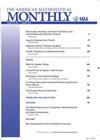随机漫步,有向环和马尔可夫链
IF 0.4
4区 数学
Q4 MATHEMATICS
引用次数: 0
摘要
摘要马尔可夫链是一个随机过程,它在状态空间中迭代移动,每次转移只依赖于当前位置而不依赖于过去位置。当状态空间是离散的时候,我们可以把马尔可夫链看作是有向图上的一种特殊类型的随机漫步。虽然马尔可夫链通常不会稳定下来,而是不断移动,但从统计意义上讲,它通常具有定义良好的极限行为。给定的有限有向图可以潜在地支持许多不同的随机漫步或马尔可夫链,每个随机漫步或马尔可夫链可以有一个或多个不变(平稳)分布。在本文中,我们探讨了刻画所有可能不变分布的集合的问题。答案很简单,很自然,涉及到图上的循环。本文章由计算机程序翻译,如有差异,请以英文原文为准。
Random Walks, Directed Cycles, and Markov Chains
Abstract A Markov chain is a random process which iteratively travels around in its state space with each transition only depending on the current position and not on the past. When the state space is discrete, we can think of a Markov chain as a special type of random walk on a directed graph. Although a Markov chain normally never settles down but keeps moving around, it does usually have a well-defined limiting behavior in a statistical sense. A given finite directed graph can potentially support many different random walks or Markov chains and each one could have one or more invariant (stationary) distributions. In this paper we explore the question of characterizing the set of all possible invariant distributions. The answer turns out to be quite simple and very natural and involves the cycles on the graph.
求助全文
通过发布文献求助,成功后即可免费获取论文全文。
去求助
来源期刊

American Mathematical Monthly
Mathematics-General Mathematics
CiteScore
0.80
自引率
20.00%
发文量
127
审稿时长
6-12 weeks
期刊介绍:
The Monthly''s readers expect a high standard of exposition; they look for articles that inform, stimulate, challenge, enlighten, and even entertain. Monthly articles are meant to be read, enjoyed, and discussed, rather than just archived. Articles may be expositions of old or new results, historical or biographical essays, speculations or definitive treatments, broad developments, or explorations of a single application. Novelty and generality are far less important than clarity of exposition and broad appeal. Appropriate figures, diagrams, and photographs are encouraged.
Notes are short, sharply focused, and possibly informal. They are often gems that provide a new proof of an old theorem, a novel presentation of a familiar theme, or a lively discussion of a single issue.
Abstracts for articles or notes should entice the prospective reader into exploring the subject of the paper and should make it clear to the reader why this paper is interesting and important. The abstract should highlight the concepts of the paper rather than summarize the mechanics. The abstract is the first impression of the paper, not a technical summary of the paper. Excessive use of notation is discouraged as it can limit the interest of the broad readership of the MAA, and can limit search-ability of the article.
 求助内容:
求助内容: 应助结果提醒方式:
应助结果提醒方式:


